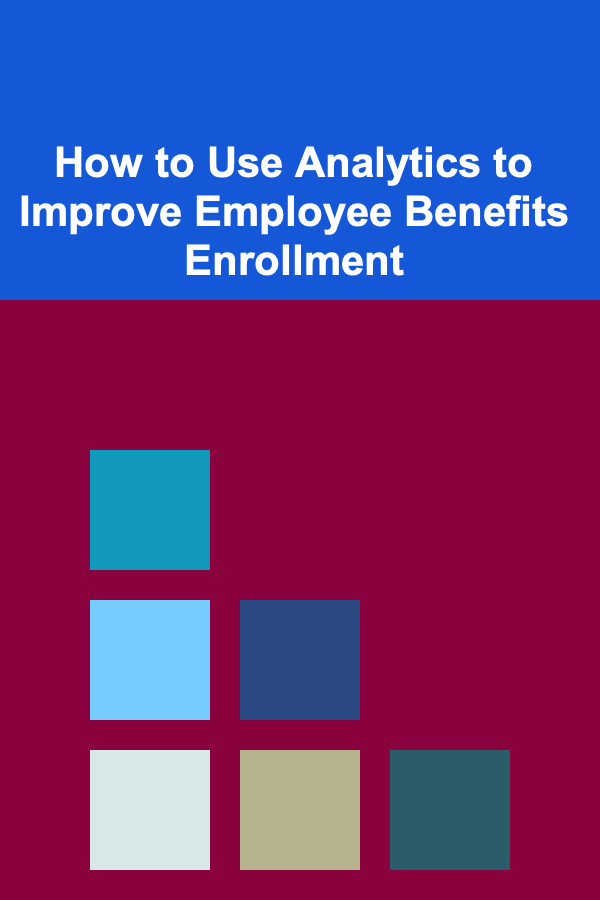
How to Use Analytics to Improve Employee Benefits Enrollment
ebook include PDF & Audio bundle (Micro Guide)
$12.99$8.99
Limited Time Offer! Order within the next:

Employee benefits enrollment is a critical process that significantly impacts both the well-being of employees and the overall success of a company's benefits program. When done well, it ensures that employees are taking full advantage of the benefits available to them. However, many organizations struggle to get high participation rates and engagement, particularly with complex benefits packages.
One way to overcome these challenges is by leveraging analytics. Data-driven decision-making can provide insights into employee preferences, behaviors, and the overall effectiveness of your benefits offerings. In this guide, we will explore how to use analytics to improve employee benefits enrollment, ensuring that employees are not only enrolled but are making informed decisions that maximize the value they receive from their benefits.
Understanding the Role of Analytics in Employee Benefits Enrollment
Analytics involves collecting, processing, and analyzing data to generate insights that guide decision-making. When applied to employee benefits enrollment, analytics can help organizations identify trends, measure the effectiveness of benefits offerings, and tailor communication strategies to better engage employees.
Key areas where analytics can improve the enrollment process include:
- Tracking Employee Engagement: Understanding how engaged employees are with the benefits program.
- Personalizing the Enrollment Experience: Tailoring benefits information to the needs and preferences of individual employees.
- Optimizing Communication Channels: Determining the best ways to reach and communicate with employees.
- Measuring and Adjusting the Effectiveness of Benefits: Tracking the impact of benefits enrollment on employee satisfaction and retention.
Tracking Employee Engagement and Behavior
Understanding employee engagement is the first step in improving benefits enrollment. By leveraging analytics tools, you can track how employees interact with the benefits enrollment platform and identify areas where engagement may be lacking.
Key Metrics to Track:
- Log-in Rates: How often are employees accessing the benefits portal? Low log-in rates may indicate issues with awareness or accessibility.
- Click-Through Rates: Are employees clicking on the links to explore the available benefits, or are they simply skimming through without engaging in the details?
- Completion Rates: What percentage of employees actually complete their benefits enrollment? A low completion rate could suggest confusion or lack of interest in the options available.
By analyzing these metrics, HR teams can spot patterns that indicate potential roadblocks in the enrollment process. For example, if employees are frequently abandoning the enrollment process mid-way, it could mean that the interface is too complicated or that they are overwhelmed by the number of choices available. With this data in hand, organizations can optimize their system to be more user-friendly or simplify the options presented.
Personalizing the Enrollment Experience
Each employee's needs and preferences vary, and personalization is key to increasing enrollment rates. Analytics can help you segment employees based on various factors like life stage, job role, and prior benefits usage. By doing so, you can tailor the benefits offerings and communication to the individual's situation.
Personalization Strategies:
- Demographic Segmentation: Use data on employees' age, family status, and location to offer benefits that are more relevant to their personal circumstances. For example, younger employees may be more interested in student loan repayment assistance, while employees with families might prioritize healthcare plans with family coverage options.
- Benefit Usage History: Analyze historical data to identify which benefits employees have used in the past. If an employee hasn't used a specific benefit, consider sending targeted reminders or educating them on how to take advantage of that benefit.
- Predictive Analytics: Use data trends to predict what benefits employees are likely to need based on their behavior and stage in life. For example, employees who have recently married might be interested in adding a spouse to their health insurance, while those nearing retirement might want information on pension plans.
By making the enrollment experience more personalized, employees will be more likely to engage with the benefits offered, resulting in higher participation rates and a better alignment between the benefits they select and their actual needs.
Optimizing Communication Channels
Effective communication is crucial for encouraging employees to participate in benefits enrollment. However, not all employees respond to the same type of communication. Some prefer email reminders, while others may prefer text messages or phone calls. By analyzing data on communication preferences, HR teams can ensure they are using the most effective channels to reach employees.
Communication Analytics Strategies:
- Surveying Employees: Regularly survey employees about how they prefer to receive benefits information. Use this feedback to adjust your communication strategies and offer content through the channels most likely to engage your workforce.
- A/B Testing: Run A/B tests on different communication formats (e.g., email vs. SMS vs. mobile app push notifications) to determine which one yields the highest engagement rates during the enrollment period.
- Timing and Frequency: Analyze the optimal timing and frequency for communication. For instance, is sending weekly email reminders effective, or would fewer, more targeted messages be better received? Use analytics to fine-tune the timing of benefits communications to align with employees' behaviors and preferences.
Measuring and Adjusting the Effectiveness of Benefits
Analytics can also be used to evaluate how well the benefits program is performing. Key performance indicators (KPIs) such as employee satisfaction, retention rates, and health outcomes can give you valuable insights into whether your benefits offerings are meeting employee needs.
Key Performance Indicators (KPIs) to Track:
- Enrollment Participation Rates: Track overall participation and identify trends or disparities among different employee groups. A drop in participation could signal that the benefits being offered aren't resonating with employees, or that they face barriers to completing enrollment.
- Employee Satisfaction Surveys: Use post-enrollment surveys to assess how satisfied employees are with their benefits options. Are employees clear about their benefits, and do they feel confident in their selections?
- Health and Wellness Metrics: If your benefits package includes wellness programs, track the participation and effectiveness of those programs. Are employees utilizing health screenings, gym memberships, or wellness coaching? These insights can help optimize future benefits offerings.
- Turnover and Retention: Employee turnover can be influenced by the benefits provided by an employer. If employees feel that their benefits package is lacking, it could contribute to dissatisfaction and ultimately affect retention. Tracking turnover rates in relation to benefits satisfaction can help HR teams make adjustments to the offerings.
By monitoring these KPIs, HR professionals can gauge whether their benefits program is effective and make data-driven adjustments for future enrollment periods. If data suggests that certain benefits are underutilized or that employees are disengaged, it may be time to reevaluate the offerings or find ways to better communicate their value.
Leveraging Technology for Analytics in Benefits Enrollment
To fully harness the power of analytics in employee benefits enrollment, it is important to utilize the right tools and platforms. Many modern benefits administration software systems come equipped with built-in analytics capabilities. These platforms can provide real-time data, tracking tools, and customizable reports that enable HR teams to make informed decisions.
Tools and Technologies to Consider:
- Benefits Administration Software: Platforms like Zenefits, Gusto, or Workday offer advanced analytics features that track enrollment data, employee interactions, and benefit usage.
- Survey Tools: Tools like SurveyMonkey or Google Forms can be used to gather feedback from employees during or after the enrollment process. This data can be analyzed to determine the effectiveness of communications and whether the benefits offered meet employee needs.
- HR Analytics Platforms: Dedicated HR analytics platforms like Visier or Tableau can aggregate data from multiple sources and provide insights into overall benefits program effectiveness, engagement levels, and employee satisfaction.
These tools make it easier for HR professionals to track and analyze the data necessary to improve employee benefits enrollment and ensure that their offerings are aligned with employee needs.
Conclusion
Using analytics to improve employee benefits enrollment is not just about increasing participation rates---it's about creating a more tailored, effective, and engaging benefits experience for employees. By leveraging data to understand employee behavior, preferences, and engagement patterns, organizations can make informed decisions that lead to better outcomes for both employees and employers.
Through tracking engagement metrics, personalizing the enrollment process, optimizing communication channels, and continuously measuring program effectiveness, you can significantly enhance your benefits enrollment strategy. With the right tools and data, you'll be able to foster a benefits program that truly supports your workforce's well-being while driving organizational success.
Reading More From Our Other Websites
- [Horseback Riding Tip 101] Saddle Fit: How to Measure, Test, and Adjust for Optimal Horse‑Rider Harmony
- [Organization Tip 101] How to Digitize Your Collection Records for Better Tracking
- [Home Budget 101] How to Use Your Net Worth Statement to Inform Your Home Budget Decisions
- [Home Soundproofing 101] How to Create DIY Acoustic Panels That Work for Any Home Environment
- [Organization Tip 101] Minimalist Home Office Accessories That Will Elevate Your Space
- [Home Budget Decorating 101] How to Mix Old and New Items for a Budget-Friendly Decor Look
- [Organization Tip 101] What Are the Must-Have Items for a Well-Organized Garage?
- [Home Holiday Decoration 101] How to Create a Kid-Friendly Holiday Decorating Scheme
- [Home Budget 101] How to Budget for a Wedding when Paying it All by Yourself
- [Reading Habit Tip 101] Best Techniques to Transform a Day‑Long Conference into a Reading Opportunity

How to Design T-Shirts That Sell on POD
Read More
How to Save on Home Renovation Costs While Sticking to a Budget
Read More
How to Secure Your Cryptocurrencies on Blockchain Networks
Read More
Top Tips for Saving Money on Household Bills Without Sacrificing Comfort
Read More
How to Get Rid of Blackheads and Whiteheads: A Comprehensive Guide
Read More
How to Integrate Reptile Enrichment into Your Care Routine
Read MoreOther Products

How to Design T-Shirts That Sell on POD
Read More
How to Save on Home Renovation Costs While Sticking to a Budget
Read More
How to Secure Your Cryptocurrencies on Blockchain Networks
Read More
Top Tips for Saving Money on Household Bills Without Sacrificing Comfort
Read More
How to Get Rid of Blackheads and Whiteheads: A Comprehensive Guide
Read More